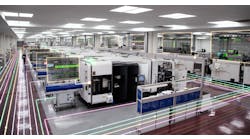A manufacturer of machined castings and forgings improved the accuracy and consistency of its part loading, reduced part defects, increased productivity, and lowered its cost per part. An automotive component supplier gained 24-hour unattended part processing to easily meet throughput requirements and eliminated the need for manual machine load/unload labor. These are only two examples of the reasons that shops should consider incorporating robots for machine tending.
There are a lot more.
In today’s manufacturing world, the one-man-onemachine scenario just doesn’t make sense when that one operator could be overseeing several machines running unattended, freeing him or her to perform other valueadded tasks.
Robots have the potential to increase productivity/machine spindle use by as much as 90 percent, according to Fanuc Robotics. In addition, shops can have robots do extra tasks such as welding, gauging, deburring and part washing.
Machine tool robotic automation can vary from machine cells using tray automation or draw-type systems to large standalone robots and top loading robots to full-out vision-guided machine-tending systems.
For the manufacturer of machined castings and forgings, robotic automation was a nobrainer.
“We realized that to position ourselves as a worldclass manufacturer, we needed to implement leading-edge technology,” the vice president of the company said. “For this particular project, speed and quality were the highest priorities because, when it comes to automotive manufacturing, there’s no margin for error.”
Prior to automation, a manual process and human limitations prevented the shop from achieving throughput and consistency requirements for a major contract to manufacture drive-shaft components for sport utility vehicles and full-size trucks. Also, safety and ergonomic issues hindered production. Employees frequently were absent due to injuries from repetitive activities, so accurate production planning was nearly impossible.
According to the shop, production complexity was another key factor in deciding to go with robotics. In addition to balancing the many different processes and types of machinery involved in production, the shop had to balance cycle times between each process. With the manual operation, bottlenecks in the system prevented achieving production goals. Now, the system produces 120 pieces per hour, a 50 percent increase from the 80 pieces per hour done manually.
The shop’s fully automated system incorporates nine Fanuc materialhandling robot models, each with Fanuc’s HandlingTool and Collision Guard software, custom grippers and a control interface to the equipment and conveyor. The handling software’s built-in functions, menu-driven prompts and point-and-shoot position teaching let operators easily create and run programs. Collision Guard allows a robot to sense potential collisions along any axis, then stops operation to minimize damage.
In operation, the first robot loads raw parts into a CNC lathe and unloads finished ones onto a part pallet on a conveyor. Each full pallet travels to a tabletop robot that loads and unloads them to and from a broach machine, to another robot for a large broaching machine, and to yet another that moves parts in and out of a boring operation.
In the final processes, a robot sequentially loads and unloads parts in and out of four machines doing various groove and reaming operations. Parts then travel to several other robots that load and unload them to and from a drilling operation, spline-rolling procedure, heat treating, and a grinding operation.
At the automotive component supplier’s shop, four Fanuc robots process parts automatically and consistently, 320 per hour in lightsout operation. Each robot sits on top of a dual-spindle lathe, which saves valuable floor space. Built-in placement-verification sensors on the robots’ grippers ensure parts are fully seated in machine chucks.






